
We paid special attention last semester to Goldberg's treatment of the Recipient, her "Ditransitive", construction. We objected to the name Ditransitive because we noted that this construction can occur in passive clauses (I was read a story), which are not transitive. That is, we want to consider this construction as capable of unifying with either of the Transitive or Passive (linking) constructions. The mechanism that assigns subject gf to the distinguished argument (DA) in a recipient structure like She threw me one is the same as the mechanism that assigns subject gf to the DA in a caused motion structure like She threw one to me. So we don't want to make assignment of subject to DA part of either the Recipient or Caused Motion constructions (among others).
Goldberg notes that when verbs of different semantic classes unify with the Recipient construction, the clauses headed by these verbs have distinct sets of entailments. For example: He handed/tossed me a cookie entails that I received a cookie; He denied/refused me a cookie entails that I did not receive a cookie; and He promised/guaranteed me a cookie entails neither that I received a cookie nor that I didn't. Goldberg proposes to account for such facts by positing polysemy of the Recipient construction, with a different subconstruction for each class of verbs. (See Constructions: Figure 2.2, p. 38, and surrounding text.) It's not clear this is necessary and if it is not necessary it is undesirable. Ideally we should be able to find a way to formulate the Recipient construction so that it will unify with verbs of all the classes, producing the observed differences in entailment simply as a result of semantic differences among the verb classes. Demonstrating this will be our first task.
Our second task is to investigate the relations between the Recipient construction, the Caused Motion construction, the Resultative construction (all studied in detail by Goldberg) and a number of additional constructions, related to these. All of the constructions in this group have in common semantically an action which causes an eventuality of some kind and have in common valence-wise three required arguments, which we will call, for want of anything better, A, B, and C. Hence, the subtitle "Causative ABC Constructions". Constructional inheritance will play a major role in the story, but not constructional polysemy. Some preliminary examples:
(1) [Ann] gave [Bob] [some Candy]. (Recipient)
(2) [Ann] opened [Bob] [a Can of peas]. (Benefactive Ditransitive)
(3) [Ann] tossed [the Ball] to [Carol]. (Caused Motion)
(4) [Ann] drove [Bob] [Crazy]. (Resultative)
(5) [Ann] keeps [the Baby] [Close]. (Immobility)
(6) [Ann] placed [the Burnoose] [in the Casket]. (Caused Location)
(7) [Ann] filled [the Box] [with Candles]. (Fill)
(8) [Ann] emptied [the Bureau] [of its Contents]. (Empty)
We will treat all of these constructions as phonologically vacuous constructions of derivational morphology. Following the unpublished work of Orhan Orgun and Jean-Pierre Koenig, each AS construction is represented as a case of non-branching dominance, a 'box-within-box', single-daughter construction. (You recall that in CG non-branching dominance occurs only in the lexicon.)
In order to ensure that a minimal lexical item can unify only with the daughter node, and not the mother node, of an AS construction, each AS construction has the notation 'min -' in its external (upstairs) structure, and each minimal lexical item carries the notation 'min +'. This prevents an off-the-shelf lexical item from unifying with the upstairs part of an AS construction.
This disposition of the min attribute is not enough, however, to prevent recursion of AS constructions, which if permitted would license disasterous infinite structures such as that indicated suggestively below.

We prevent recursion of AS constructions by a principle that prohibits vacuous unification of constructions:
Non-Identity Principle: No unique-daughter structure is permitted in which the mother and daughter feature structures are identical.
The Non-Identity Principle will allow a structure such as the one shown in Figure 2a, since mother and daugher feature structures differ on the min feature. It will block a structure such as that shown in Figure 2b, in which mother and daughter (external) feature structures are identical.

(9) The top spun.
(10) Nell spun the top.
(11) Nell spun the top off the table.
In (9) we find minimal, intransitive spin. The verb spin occurring in (10) has been formed by inserting the minimal verb spin as daughter node in a causative (zero-derivational) construction (not shown). The verb spin occuring in (11) has been formed by inserting the verb spin occurring in (10) as the daughter node in the Caused Motion construction, discussed below. Figure 3 presents abbreviated representations of these three verbs spin.

To simplify the diagrams below, some properties are not shown:
* In these - but not all - morphological constructions (with or without phonological change), the semantics and valence values of the (unique) daughter are subsets of the corresponding values of the mother. A case in which this property does not hold is the French inchoative reflexive construction, which derives an intransitive verb with inchoative meaning from a minimal transitive verb with causal meaning. For example, the minimal transitive verb éteindre 'extinguish', has both agent and patient arguments, while the derived, inchoative-reflexive verb s'éteindre 'go out', has only a patient argument. Similarly: allonger 'lengthen', s'allonger 'grow longer, stretch out'; élever 'raise', s'élever 'rise, empêtrer' hamper'; s'empêtrer 'get tangled up'; and so on. (There is strong evidence against deriving the agentives from the inchoatives.)
* A feature theory of thematic roles is assumed, according to which such labels as agent, instigator, theme and patient are abbreviations for complex feature structures, which may unify when they are compatible.
* For ease of reading, we have replaced the familiar unification variables, '#1' etc., with capital letters A, B, C and Roman numerals I, II, III, etc. These letters and numerals stand for feature structures and repetition of a letter or numeral in two places (or more) in a construction diagram means unification of the corresponding feature structures. (We found that these diagrams got hard to read with lots of '#1[ ]'s and '#2[ ]'s.)
* Predictable paths are abbreviated by their final attribute. For example 'cat v' abbreviates 'ss|syn|head|cat v'.
1. Recipient
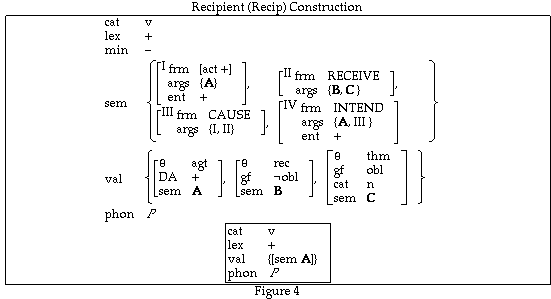
The daughter box of the construction can unify with either a minimal lexical verb or a non-minimal lexical verb. In either case the semantics of the A argument has to be compatible with action. The phonology of the daughter and mother are identical, which enables us to dispense with the attribute 'input phonology' in the mother and with mention of phonological rules deriving the phonology of the mother from its input phonology. For reasons given above, no mention of minimality need be made in the daughter box (See Figure 3 and surrounding text).
In the mother's syntax, we note that this is a lexical, non-minimal verb. The semantics value is a set with four members, indexed I, II, III, IV. These are each event structures based on frames (or relations, or predicates). About the frame of event I we stipulate only that it is active (non-stative); this largely underspecified frame will unify with the main frame of a wide variety of verbs when a minimal verb is plugged into the daughter constitutent. The valence value shows that one argument of this frame (possibly the unique one) is an agent and is assigned Distinguished Argument (DA) status by the construction. Thus in a recipient clause, someone (A) does something and the NP realizing the doer is the distinguished argument. Event II specifies the frame RECEIVE and arguments B and C. Hence in a recipient clause someone (B) receives something (C). Event III tells us that it is part of the meaning of a Recipient verb that the acting event (I) is the cause of the receiving event (II). Finally, event IV specifies that the actor (A) INTENDS III, that is, the actor intends event I to cause event II.
Picking up the valence thread again, we note that the recipient (B) is realized as a non-oblique , non-DA NP, that is, as either transitive object or passive subject, the choice depending on whether the verb licensed by Recipient also unifies with Transitive or with Passive. The theme argument is realized as an oblique NP. CG can keep the number of distinct gfs down to three: subject, object and comp/oblique because the CG valence mechanism permits reference to syntactic category, thus allowing reference to oblique NPs. The basic idea here is that Transitive, Passive and Subject constructions are available to link subject and object functions to arguments not otherwise linked to oblique functions. (Recall that 'oblique' and 'comp' functions are theoretically a single entity: in order to conform to common usage we refer to this entity as 'oblique' when the syntactic category realizing the argument is nominal or prepositional and 'comp' when it is verbal or adjectival.) By positing just the two nuclear (non-oblique) functions - subject and object - plus the single non-nuclear comp/oblique function, we simplify the descriptive task for English. Any bare NP occurring in VP which we do not have good reason to call a direct object can be classified as an oblique NP. Good reasons for calling something a direct object include immediate post-verbal position, correspondence with a passive subject (Someone ate the pizza ~ The pizza was eaten) and inheritance of an AS construction which we have independent reason to believe confers direct object status (Someone baked me a cake ~ *I was baked a cake).
Events I and IV in the sem value of Figure 4 carry the notation 'ent +'. This indicates that in every clause based on a Recipient verb the action and intention events are entailed. In (12) we note that it is not entailed that Pat RECEIVE an ice cream cone or that your act CAUSE Pat to receive an ice cream cone, although in (13) these entailments are present. Later we will see that the additional entailments in (13) derive from properties of the verb give, rather than from propeties of the Recipient AS construction.
(12) You promised Pat an ice cream cone.
(13) You gave Pat an ice cream cone.
(We envision the entailment feature of a complex lexical predictor being accompanied by a presupposition feature. The entailment and presupposition features give us a way of expressing the fact that entailments and presuppositions of complex predicators do not always follow from relations of scope present in the semantic decomposition of the predicator.)
There are some additional fussy details about the Recipient construction that we have not included in Figure 4. First, there are the facts we covered last semester about non-left-isolation (non-extraction) of non-subject recipients, illustrated in (14)
(14) *the person who you gave an ice cream cone
Also, in the Recipient construction the oblique nominal cannot in most (any?) circumstances be a definite personal pronoun, as illustrated in (15-17).
(15) *She gave John it.
(16) I gave John that.
(17) She gave John one.
(18) ?Gimme it.
1.1 Lexical classes
We now turn to the task of showing that the differences in entailment that accompany the use of different (classes of) verbs in the Recipient construction follow from the inherent semantics of the verbs and do not justify postulation of polysemy in the Recipient construction. Much of the work here will be done by the fact that many of these verbs include a modal meaning which affects their semantics in the Reciprocal construction just as it does in other AS configurations.
Thus, the verb deny has a meaning inherently involving negation, which shows up in a non-recipient sentence like (19) as well as in Recipient sentences. Similarly for promise and 'future' modality ('ought-ness', what 'should' be the case) (see 20), allow and possibility (21), bequeath and futurity (22).
(19) My client denies the allegations.
(20) Promise to be nice to my bear.
(21) Pious allowed the cream to sour.
(22) I bequeath my library to Tilden Pre-School.
The fact that different verb classes entail different selections from the four semantic events in Recipient also accounts for some of the semantic differences among verb classes that lead Goldberg to postulate constructional polysemy. That is, minimal verbs that specify a given event in their semantics may differ in whether or not they entail it. Give and promise both evoke a RECEIVE event, but only give entails this event.
1.1.1 AG's Class A
We treat Goldberg's class A, the non-modalized, 'central' Recipient class, as containing two subclasses, depending on the number of inherent arguments of the minimal verb. Verbs like give, hand and pass begin life with three arguments; verbs like throw and toss with two, a third being added sometimes by Recipient or Caused Motion.
(23) She threw the rock. (2 arguments)
(24) Don't throw me that rock. (3 arguments. Recipient Const. present)
(25) Someone threw a rock through my window. (3 arguments. Caused Motion Const. present)

(26) ??He gave the jewels to me but they were intercepted by a thief.
Figure 6 shows that subclass 2 verbs, on the other hand, do not impose entailments of events II and III. Thus, sentences like (27) are unproblematical.
(27) I threw {you the ball/the ball to you} but it was intercepted by an opponent.
The minimal lexical verbs schematically represented in Figures 5 and 6 can unify with the daughter box of Recipient, which is unmarked for minimality, but cannot unify with the mother structure, which is marked 'min -'. This observation will not be repreated in our discussion of the additional verb classes. Note also that the valences of the minimal verbs shown in Figures 5 and 6 are compatible with the valence of the Recipient construction, a second observation not to be repeated in our discussions of additional verb classes.
1.1.2 AG's Class E
Goldberg's class E contains verbs like allow and permit. These verbs always involve the performance of an act (including perhaps 'acts' of the kind performed by forces of nature, such as when the weather permits the lake to freeze - or causal circumstance more generally, as when an open window allows the heat to escape) which makes it possible for some participant distinct from the actor or causal force to be subject to some further eventuality.
(28) Harry allowed the butter to melt.
With these verbs, the causal event (III) is entailed but what is caused is not the caused event (II) simpliciter but rather the caused event under the modality of possibility. If I allow the children to play outdoors I make it possible for them to do so. They may end up remaining indoors nonetheless. (Often the caused event simplicter will be conversationally implicated, but that is another matter.)
Goldberg glosses the meaning of her class E subconstruction of Recipient as "Agent enables recipient to receive patient." On the present analysis there is no such subconstruction. Allow means in part, "Instigator enables something to happen" and the Recipient AS construction specifies semantically "Agent intentionally causes someone to (modal) receive something." Since Instigator can unify with Agent and "someone receives something" can unify with "something happens", the minimal verb can unify with the AS construction and the resulting derived verb take on the meaning of that construction, including the notion of receiving. We don't need to posit constructional polysemy.


We consider verbs of this class to be raising-to-object verbs. The valence of verbs of this class provides for a non-oblique, non-DA argument and specifies that this argument to play no semantic role with regard to the governing predicator. Consider
(29)a The old man allowed the children to climb on him.
(29)b She allowed nothing to happen.
A sentence like (29)a seems to suggest involvment between the old man and the children, which might lead to a hasty judgment that this is a control (equi) situation. But considering (29)b it becomes apparent that the semantic participants for allow are just the allower and the event that is allowed. The dummy objects occurring in (30) confirm this.
(30)a She allowed it to become obvious that she was dissatisfied.
(30)b I hope the picnic gods don't permit there to be another plague of ants this year.
The semantic feature structure abbreviated as B is not an argument of allow/permit; it is only an argument of the complement of allow/permit.
But a glitch surfaces, as was pointed out in class. If the B valence element of minimal allow is theta null as we indicate in Figure 7, then this minimal verb can't unify with Recip, assuming we stick to our assumption that in Recip the downstairs valence is a subset of the upstairs valence. We can't add a theta null valence element upstairs in Recip because it won't ever get realized in actual Recip clauses. Recip clauses are not raising-to-object. When class E verbs unify with Recip, the non-DA, non-obl ("underlying object") element has to be the recipient (B) element. We can get around the problem by partially suspending the assumption that the downstairs valence in Recip is a subset of the upstairs valence, allowing for a '[gf ~obl, theta rec]' element upstairs to replace the '[gf ~obl, theta null]' element downstairs. We noted in the case of the French inchoative reflexive that derived valences do not always include the full downstairs valence. Morphological constructions normally derive something closely related to their input. It would be nice if we could strictly limit derivational operations to monotonic additions to input, but apparently, although this restriction is very widely obeyed, it is not exceptionless.
Another matter came up in class that merits further discussion. It should have been made clearer than it was that sentences like They permitted me access [to the documents] and They allowed me entry [to their clubhuse] are not Recip sentences. Deverbal nouns, like access and entry head predicational complements that are analogous to VP[to] and other [srs -] complements in containing a subject valence element that must be satisfied by coinstantiation. They allowed him entry to their clubhouse is analyzed like They allowed him to enter their clubhouse, with the subject valence requirement of enter/entry controlled by him. We can imagine that a construction similar to that given in Figure 8 provides nominally headed comp valence elements for the linking of event structures in the semantics of verbs like allow and permit, and also have, gain, get, provide, lose, deny, ... (essentially verbs of having or getting, including negatives).

1.1.4 AG's Class B
Goldberg's class B includes verbs like promise and guarantee. Whereas in the bequeath class, just discussed, the minimal verb requires three arguments: legator, heir and legacy, this is not the case with verbs of the promise, guarantee class. These verbs require only an undertaker of an obligation and the content of the obligation.
(31)a I promise to arrive early.
(31)b I guarantee that it will rain.
When the content of the obligation fits the semantics of an event in which a recipient receives a theme, unification with the Recipient AS construction is possible.
(32)a You promised me an ice cream cone [= that I would receive an ice cream cone]
(32)b I was guaranteed a ticket to the concert [= that I would receive a ticket to the concert]
The semantics of a verb like promise entails that the promiser A commits an act (I) that causes (III) a state of affairs (IV) which consists in A's being obligated to a further state of affairs (V) in which A intends a yet further state of affairs (II) to come about, whose organizing frame is unspecified and in which B and C are involved. It is entailed by promise that (i) A acts, that (ii) that act cause a state of affairs in which A is obligated to have a certain intention and (iii) that the obligation state of affairs obtains. Promise entails neither (i) that A have the intention which is the object of the obligation nor (ii) that the state of affairs which is the object of A's intention obtain. If I promise to give you an ice cream cone, it is entailed that I act (e.g., I say, "I promise you an ice cream cone.") and that act bring about a situation in which I am obliged to harbor the intention that you get an ice cream cone. It is not entailed that I actually harbor the intention in question or that you actually receive an ice cream cone. You can break a promise, but the result is a broken promise, not a clear conscience.
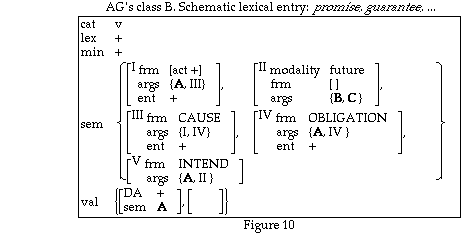
The valence in Figure 10 indicates that verbs of the promise class have at least one element other than the DA actor but specify nothing further about this (or these) element(s).
(Examples like I promise you it's raining in London right now seem to violate future modality, but such example employ a different verb promise from the promise that unifies with Recip. The promise that unifies with Recip entails commitment to a future action by the promiser. The promise of the example beginning this parenthesis entails the promiser's certifying the truth of a proposition.)
(Goldberg includes the verb owe in this class, but while owe fits Recipient syntax it does not fit Recipient semantics: there is no act and no causality; owe is a pure stative: *You are owing me twenty dollars. Other verbs with Recipient-like syntax not licensed by the Recipient construction include: cost [you] [$5], take [me] [an hour], and last [her] [a year].)
1.1.5 AG's Class C
Goldberg's class C contains the verbs refuse, deny and spare. Spare has valence restricted to the Recipient construction.
(33) *The schoolmaster spared a punishment to the pupil.
The verbs refuse and deny occurring in the Recipient construction seem to be special minimal verbs dedicated exclusively to this AS pattern, meaning (in part) 'cause to fail to receive'. (What we implied about deny in connection with example (19) was therefore not quite true.) These verbs have a semantics similar to that of give, except for adding narrow scope negation over the RECEIVE frame. Recipient deny and refuse do not represent the ordinary meanings or argument structures of deny and refuse. Ordinarily, to deny X is to claim that X is untrue, where the semantic type of X is a proposition (or whatever semantic type one considers truth to be predicable of). But sentences like (34), using deny in Recipient semantics are no good and sentences like (35), in which the X argument of deny in a simple transitive sentence is not a proposition, are also no good.
(34) *I proudly denied my theology professor the Manichaean heresy.
'I proudly asserted to my theology professor the falsity of the Manichaean heresy'.
(35) *I denied the ice cream cone.
A similar argument can be constructed for refuse; the task is left to the reader.
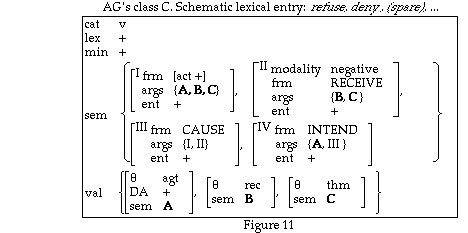
Recipient deny and refuse share with give the specification of the caused (II) frame as RECEIVE and the entailment of all four eventualities in the semantics. The modality of negation on the RECEVE frame is no doubt historically connected to the idea of negation in ordinary refuse and deny.
1.2 Benefactive-Ditransitive (B-D) Construction
According to Goldberg, sentences like
(36) I baked Kim a cake.
(37) I bought Kim a book.
are licensed by a subconstructions of the polysemous Recipient construction. Although we reject the idea of constructional polysemy, we agree that sentences like (36) require postulation of an AS construction which is distinct from, although related to, Recipient. The key difference between Recipient and the construction licensing a sentence like (36) or (37) is that the caused event (II) in what we call the Benefactive-Ditransitive (B-D) construction is not framed by RECEIVE but by BENEFIT-FROM. Often, pragmatic reasoning will lead to an interpretation in which the nature of the benefit to the B argument is receipt of the C argument. This is particularly true for verbs of creation like bake or verbs of obtaining like buy. But, in the first place, it is noticeable that verbs from these classes take benefactive obliques in for, not path (or goal) obliques in to.
(38) I baked a cake for Kim.
(39) *I baked a cake to Kim.
(40) I bought a book for Kim.
(41) *I bought a book to Kim.
If the semantic role of Kim in (36) and (37) is recipient, rather than beneficiary, why should (39) and (41), which attempt to code Kim as an oblique recipient, be ungrammatical? On the other hand, if the role of Kim in (36) and (37) is beneficiary, no ad hoc semantic stipulation is required to account for the fact that (38) and (40) are grammatical and (39) and (41) are not.
Turning to verbs outside of the creation and acquisition (e.g., bake and buy) classes, we find the pragmatic default to reception less salient. A sentence like
(42) I'll peel you an orange.
can answer to your desire for orange pulp, juice or peel, but also to your wish to see if the new orange peeler works, or to your desire to know whether my injured hand has regained its dexterity. I need not have in mind that you will receive orange products to utter (42) felicitously, only that you will benefit in some way from the act of my peeling an orange.
Syntactic evidence that these sentences are licensed by a construction distinct from Recipient is provided by the fact that such verbs do not unify with Passive, as shown in (43-45), although the corresponding underived verbs passivize readily (46-49), as do the versions with an oblique beneficiary (49-51).
(43) *Kim was baked a cake (this morning) (by me).
(44) *Kim was bought a book (at Cody's) (by me).
(45) *Madge was peeled an orange (adroitly) (by me).
(46) The cake was baked this morning.
(47) The book was bought at Cody's.
(48) The orange was peeled adroitly.
(49) A cake was baked for Kim
(50) This book was bought at Cody's.
(51) That orange was peeled for Madge.
Resistance to passive motivates the use of the word 'Ditransitive' in the name we give the construction. Unlike the Recipient construction, which is compatible with Passive, the Benefactive-Ditransitive always licenses a direct object and does not co-occur with passive morphology. In B-D the valence entry for the benefactive (B) argument encodes this fact by stipulating obj. (Compare the more general stipulation of non-oblique this argument receives in Recipient.)

A wide range of transitive verbs is compatible with the B-D construction. These include, as noted, creation verbs like bake, make, build, ..., verbs of acquisition such as get, steal, catch, ..., and also a wide range of other verbs, some of which involve changing the form of something: peel, chop, squeeze, ... It is not the case, however, that every transitive clause with a beneficiary argument can be matched by a B-D clause in English.
(52) ??He conjugated her a Latin verb. (cf. He conjugated a Latin verb for her.)
(53) *The doctor removed him a wart. (cf. The doctor removed a wart for him.)
The last observation suggests there is probably a semantic constraint on the Benefactive-Ditransitive construction we have not discovered. (Constructions in languages such as French and German with semantic effects similar to English B-D, and which involve dative case, are less restricted semantically than B-D.)
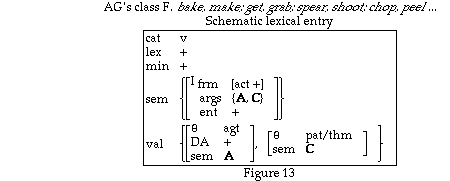
Goldberg studies two other constructions that bear similarities to Recipient and Benefactive-Ditransitive. These are the Caused Motion construction, illustrated in (52, 53) and the Resultative construction, illustrated in (54, 55).
(52) Tim gave a book to Kim.
(53) A ball was thrown through the window.
(54) She beat the rug clean.
(55) The rag was squeezed dry.
2.1 The Caused Motion Construction
You will recall that Goldberg argues from examples such as (56, 57) that a Caused Motion AS construction with three arguments must be postulated.
(56) He sneezed the tissue off the table.
(57) They laughed me out of the room.
The semantics of the verbs sneeze and laugh do not alone provide the number and kind of argument slots necesary for sentences (56) and (57) and to propose special verbs sneeze, laugh, etc. meaning 'cause to move by sneezing/laughing/etc.' misses the generality of the pattern exhibited here.
The key feature of exx (56) and (57) is that the minimal verbs are intransitive. This undercuts a popular competing analysis of sentences like
(58) He hit the ball over the fence,
In which pragmatic reasoning operates on the interpretation 'HIT(he, ball) & OVER(ball, fence)', (which are held to arise from the fact that HIT and OVER are each inherently 2-place predicates) to associate the second argument of HIT with the first argument of OVER, requiring no special three-argument construction to compose the semantics. Although examples like (58) are much easier to find than examples like (56) and (57), we accept Goldberg's proposal of a special, three-argument Caused Motion construction here.
Caused Motion is the construction we ordinarily think of as alternating with Recipient.
(59) Toss Tiny the bean bag. (Recipient)
(60) Toss the bean bag to Tiny/here/around/out the window. (Caused Motion)
In the notation we have developed in these lectures, the Caused Motion construction may be expressed as follows.
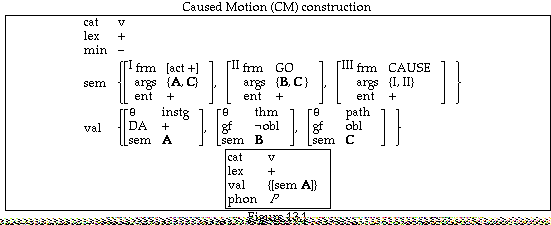
Similarities with Recipient and B-D are apparent. There is an action event (I), a second event (II), and a third, causal, event (III) of which the causer participant is I and the caused participant is II. The actor (A) in I is the DA and there are two syntactic complements in the valence besides the one corresponding to A. If frame II were RECEIVE or BENEFIT-FROM, instead of GO, we would be looking at something very like Recip or B-D, except for the INTEND event.
2..2 The Resultative Construction
As you will recall from last semester, Goldberg proposes a single AS construction to account for sentences like (61), in which a result such as the tables becoming clean seems implied in the notionally transitive action of wiping the table, (62), in which no particular result (such as the stone becoming dry) is implied in the notionally transitive action of shaking a stone, and (63) in which the verb cry does not denote a transitive action at all: the relexive himself is a 'false object'.
(61) He wiped the table clean.
(62) He shook the stone dry.
(63) He cried himself hoarse.
Goldberg posits an AS construction, with places for an agent, a patient and the result that the agent's action on the patient engenders. In our notation such a construction can be represented as follows.
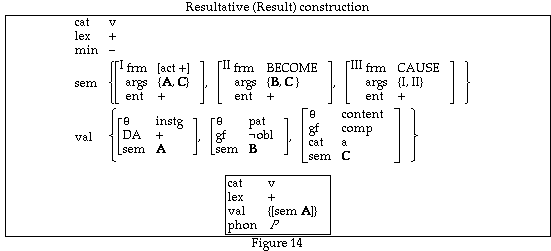
3. The ABC Family of Constructions
The similarities that we noted among the Recip, B-D, CM and Result constructions can be expressed in a more abstract construction, which is inherited by each of these. We'll call this the ABC construction for now; if you can come up with a more insightful, descriptive or euphonious name please let us know. Once the ABC construction is stated, expressing what Recip, B-D, CM and Result have in common, each of those constructions can be represented more succinctly by indicating inheritance of ABC and suppressing redundant information.

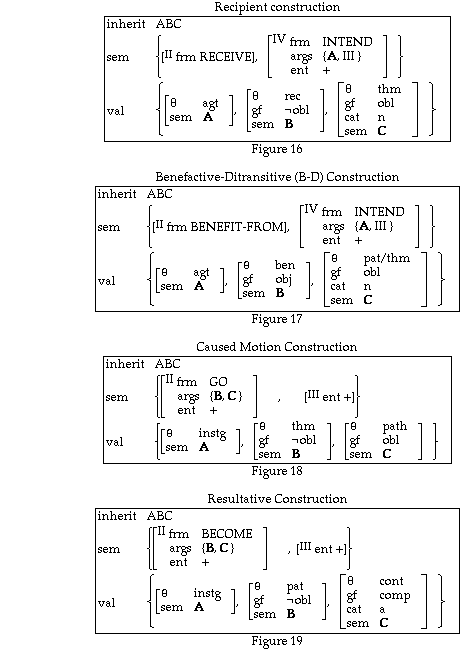
The general ABC pattern, in which an action event causes some other event with three valence elements expressed, has further instantiations. Figure 20 blocks out the full ABC territory. The first four heirs of ABC (from the left) are the AS constructions we have considered above.

In Figure 20, each construction is supplied with a sample verb or two. In some cases, the semantics of the verb matches perfectly, or almost perfectly, the semantics of the AS construction.
Perhaps the most convincing examples of this for the four constructions we have considered above are give for Recip and make for Result. In these cases (and also the cases of keep and put, which we haven't discussed yet), the semantics of the verb seems to contain little that isn't in the AS construction and vice versa. Goldberg asks us to think of these argument structures as representing "events essential to human experience" (p. 39). This may be true in many cases, but it is also possible to think of the AS constructions as in some sense 'derived from' the semantics of their most neutral verbs. For example we might, if we wished, think of the Recip pattern as reflecting a 'projection' of the semantics (and partially of the syntax) of give, though when we come to propose this seriously we will have to specify just what sort of 'projection' we are talking about: historical, ontogenetic, conceptual, etc., and what the mechanism is according to which the pattern of the verb is projected to the more general pattern. Fillmore (and Atkins? reference?) have also pointed out that AS patterns can provide a syntax for quite restricted and culturally circumscribed event types. The syntax of gambling: gamble/bet/wager X on Y can, perhaps unsurprisingly given the preposition on, be extended to caused-location verbs like put or place, But this AS pattern is also extended to verbs of the semantically richer risk, chance, venture, hazard class.
(64) I bet/gambled $10 on that horse.
(65) I put/placed $10 on that horse.
(66) I risked/chanced $10 on that horse.
The conceptual and historical significance of argument structure constructions and the relation of AS constructions to verbs whose semantics matches them closely provide a source of interesting questions, but as yet few persuasive answers.
3.3 More ABC Constructions
The ABC constructions to be proposed in this section are not discussed by Goldberg. We do not attempt to provide exhaustive justification for the existence of these constructions. The kinds of evidence presented for the existence of the ABC constructions discussed above point to the existence of the constructions introduced and briefly exemplified in this section.
3.3.1 Caused Immobility (CI) Construction
Examples like (67, 68) argue for the existence of a Caused Immobility construction, analogous to the CM construction. Ordinarily shut doesn't accept a cat as the referent of its object nor lock a person. In the CI construction, what is caused is non-motion, rather than motion.
(67) I shut the cat in the cupboard.
(68) She locked me in the cellar.

The formulation of CI in Figure 21 expresses the idea of B's remaining at C as the negation of an event in which B leaves C. The C argument receives a location theta role.
We should notice that the CI construction is not sufficient to license a sentence like
(68) She locked me into the closet.
Sentence (68) entails not only that she kept me from leaving the closet but also that she caused me to be in the closet. The construction of Figure 21 does not yield the latter entailment. It is tempting to think of examples such as (68), with a directional as against merely locational preposition, as licensed by the CM construction, that is as analogous to
(69) She pushed me into the closet.
In the case of example (68), we must asssume that the infrence that I remain in the closet derives from our knowledge of the practical consequences of locking a door.
3.3.2 Caused Location Construction
A verb like put evokes a scenario with three arguments, agent, theme and location in which the action of the agent causes the theme to be at the location:
(70) He put the burnoose in the casket.
A sentence like
(71) She built the house on a hill.
has a structurally analogous meaning, although the verb build does not minimally provide for three arguments.

The spray/load alternation, so called, is a favorite topic of students of the relation of lexical semantics to syntax in English. Examples (72) and (73) are instances of the CL construction.
(72) They loaded hay on the truck.
(73) They sprayed paint on the wall.
Examples (74) and (75) are examples of something else.
(74) They loaded the truck with hay.
(75) They sprayed the wall with paint.
In (74) and (75) the location at which the theme ends up is linked to a nuclear gf, object or (passive) subject. It has often been claimed that (74, 75) force a wholistic interpretation, in which the whole truck or wall is filled or covered with hay or paint, while this is not the case with (72, 73). Beth Levin (in the book you read last semester: English Verb Classes and Alternations: p.118) points out, however, that while the wholistic interpretation seems to arise for several of the relatively small number of verbs that alternate between the AS of (72-73) and that of (74-75), that (i) most verbs who take one of these ASs take only one of them and (ii) many of the verbs that take only the AS illustrated with (74-75) do not yield the wholistic interpretation. For example, in
(76) They anointed Clara's head with oil.
(77) They decorated the Christmas tree with a silver star at the very top.
(78) The teacher was bombarded with spitballs.
we do not get the impression that Clara's whole head was covered with oil, and so on. The wholistic interpretation for the alternating verbs is probably best considered to arise, via implicature, from the fact that the speaker has chosen to say that the location argument has the theme located at it while rejecting an available alternative in which one could say that the theme was moved to the location. (That was put clumsily, but I hope the intention is clear. The meanings of the constructions about to be presented are hard to gloss in fluent English.)
There is a similar alternation that involves taking the theme away from the location, as against moving the theme to the location.
(79) They emptied the water from the pool.
(80) They emptied the pool of water.
The AS in (80) is much like that in (74-78), except that instead of the location being caused to have the theme located at it the location is caused not to have the theme located at it.

